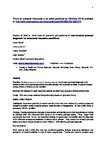Impact of fetal or child loss on parents' perceptions of non-invasive prenatal diagnosis for autosomal recessive conditions
| dc.contributor.author | Pisnoli, L | |
| dc.contributor.author | O'Connor, A | |
| dc.contributor.author | Goldsmith, L | |
| dc.contributor.author | Jackson, L | |
| dc.contributor.author | Skirton, Heather | |
| dc.date.accessioned | 2018-08-13T13:55:22Z | |
| dc.date.available | 2018-08-13T13:55:22Z | |
| dc.date.issued | 2016-03 | |
| dc.identifier.issn | 0266-6138 | |
| dc.identifier.issn | 1532-3099 | |
| dc.identifier.uri | http://hdl.handle.net/10026.1/12082 | |
| dc.description.abstract |
OBJECTIVE: to explore parents' personal attitudes towards non-invasive prenatal diagnosis in the context of their own experiences caring for a child affected with a genetic condition or after the loss of a fetus, infant, or child due to the condition. METHODS: we collected in-depth data from parents via either focus groups or individual interviews. DESIGN: this was a cross-sectional interpretive study based on grounded theory. SETTING: United Kingdom. PARTICIPANTS: 17 parents (13 women and four men) who were carriers of a serious autosomal recessive condition: spinal muscular atrophy, cystic fibrosis or thalassaemia. All had a child (living or deceased) with the condition. FINDINGS: parents experienced changes in reproductive self-identity due to their experiences of having an affected child: this influenced their views of non-invasive prenatal testing. They began their reproductive journeys 'naively', but described feelings of reproductive vulnerability after the diagnosis of the child and consequent realisation of risks to future children. They viewed non-invasive prenatal testing as a way to reduce threats to unborn children, while allowing prenatal diagnosis. KEY CONCLUSIONS: when parents lose a child they may use emotional guarding, delayed pregnancy disclosure and avoidance of harmful activities to cope in future pregnancies. Parents who want to consider early prenatal testing are less able to utilise these strategies, but non-invasive methods allow them to reduce the risk. IMPLICATIONS FOR PRACTICE: midwives should be sensitive to parents' reproductive vulnerability after genetic diagnosis of a child and ensure they are supported to consider the option of non-invasive prenatal testing if appropriate. | |
| dc.format.extent | 105-110 | |
| dc.format.medium | Print-Electronic | |
| dc.language | en | |
| dc.language.iso | en | |
| dc.publisher | Elsevier BV | |
| dc.subject | Carrier status | |
| dc.subject | Parent | |
| dc.subject | Psychological impact | |
| dc.subject | Genetic disease | |
| dc.subject | Non-invasive | |
| dc.subject | testing | |
| dc.title | Impact of fetal or child loss on parents' perceptions of non-invasive prenatal diagnosis for autosomal recessive conditions | |
| dc.type | journal-article | |
| dc.type | Journal Article | |
| dc.type | Research Support, Non-U.S. Gov't | |
| plymouth.author-url | http://gateway.webofknowledge.com/gateway/Gateway.cgi?GWVersion=2&SrcApp=PARTNER_APP&SrcAuth=LinksAMR&KeyUT=WOS:000373483800016&DestLinkType=FullRecord&DestApp=ALL_WOS&UsrCustomerID=11bb513d99f797142bcfeffcc58ea008 | |
| plymouth.volume | 34 | |
| plymouth.publication-status | Published | |
| plymouth.journal | MIDWIFERY | |
| dc.identifier.doi | 10.1016/j.midw.2015.12.009 | |
| plymouth.organisational-group | /Plymouth | |
| plymouth.organisational-group | /Plymouth/Faculty of Health | |
| dc.publisher.place | Scotland | |
| dcterms.dateAccepted | 2015-12-26 | |
| dc.identifier.eissn | 1532-3099 | |
| dc.rights.embargoperiod | No embargo | |
| rioxxterms.versionofrecord | 10.1016/j.midw.2015.12.009 | |
| rioxxterms.licenseref.uri | http://www.rioxx.net/licenses/all-rights-reserved | |
| rioxxterms.licenseref.startdate | 2016-03 | |
| rioxxterms.type | Journal Article/Review |


